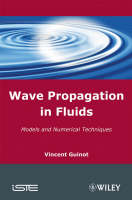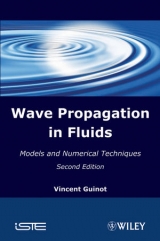
Wave Propagation in Fluids
ISTE Ltd and John Wiley & Sons Inc (Verlag)
978-1-84821-036-3 (ISBN)
- Titel erscheint in neuer Auflage
- Artikel merken
Vincent Guinot is professor of hydrodynamic modeling at the University of Montpellier, France. He teaches fluid mechanics, hydraulics, numerical methods and hydrodynamic modeling.
Introduction xv
Chapter 1. Scalar Hyperbolic Conservation Laws in One Dimension of Space 1
1.1. Definitions 1
1.1.1. Hyperbolic scalar conservation laws 1
1.1.2. Derivation from general conservation principles 3
1.1.3. Non-conservation form 6
1.1.4. Characteristic form – Riemann invariants 7
1.2. Determination of the solution 9
1.2.1. Representation in the phase space 9
1.2.2. Initial conditions, boundary conditions 12
1.3. A linear law: the advection equation 14
1.3.1. Physical context – conservation form 14
1.3.2. Characteristic form 16
1.3.3. Example: movement of a contaminant in a river 17
1.3.4. Summary 21
1.4. A convex law: the inviscid Burgers equation 21
1.4.1. Physical context – conservation form 21
1.4.2. Characteristic form 23
1.4.3. Example: propagation of a perturbation in a fluid 24
1.4.4. Summary 28
1.5. Another convex law: the kinematic wave for free-surface hydraulics 28
1.5.1. Physical context – conservation form 28
1.5.2. Non-conservation and characteristic forms 29
1.5.3. Expression of the celerity 31
1.5.4. Specific case: flow in a rectangular channel 34
1.5.5. Summary 35
1.6. A non-convex conservation law: the Buckley-Leverett equation 36
1.6.1. Physical context – conservation form 36
1.6.2. Characteristic form 39
1.6.3. Example: decontamination of an aquifer 40
1.6.4. Summary 42
1.7. Advection with adsorption/desorption 42
1.7.1. Physical context – conservation form 42
1.7.2. Characteristic form 45
1.7.3. Summary 47
1.8. Conclusions 48
1.8.1. What you should remember 48
1.8.2. Application exercises 48
Chapter 2. Hyperbolic Systems of Conservation Laws in One Dimension of Space 55
2.1. Definitions 55
2.1.1. Hyperbolic systems of conservation laws 55
2.1.2. Hyperbolic systems of conservation laws – examples 57
2.1.3. Characteristic form – Riemann invariants 59
2.2. Determination of the solution 62
2.2.1. Domain of influence, domain of dependence 62
2.2.2. Existence and uniqueness of solutions – initial and boundary conditions 64
2.3. Specific case: compressible flows 65
2.3.1. Definition 65
2.3.2. Conservation form 65
2.3.3. Characteristic form 68
2.3.4. Physical interpretation 70
2.4. A 2×2 linear system: the water hammer equations 71
2.4.1. Physical context – hypotheses 71
2.4.2. Conservation form 73
2.4.3. Characteristic form – Riemann invariants 78
2.4.4. Calculation of the solution 82
2.4.5. Summary 87
2.5. A nonlinear 2×2 system: the Saint Venant equations 87
2.5.1. Physical context – hypotheses 87
2.5.2. Conservation form 88
2.5.3. Characteristic form – Riemann invariants 94
2.5.4. Calculation of solutions 105
2.5.5. Summary 112
2.6. A nonlinear 3×3 system: the Euler equations 112
2.6.1. Physical context – hypotheses 112
2.6.2. Conservation form 114
2.6.3. Characteristic form – Riemann invariants 118
2.6.4. Calculation of the solution 122
2.6.5. Summary 126
2.7. Summary of Chapter 2 127
2.7.1. What you should remember 127
2.7.2. Application exercises 128
Chapter 3. Weak Solutions and their Properties 135
3.1. Appearance of discontinuous solutions 135
3.1.1. Governing mechanisms 135
3.1.2. Local invalidity of the characteristic formulation– graphical approach 138
3.1.3. Practical examples of discontinuous flows 140
3.2. Classification of waves 143
3.2.1. Shock wave 143
3.2.2. Rarefaction wave 144
3.2.3. Contact discontinuity 145
3.2.4. Mixed/compound wave 145
3.3. Simple waves 146
3.3.1. Definition and properties 146
3.3.2. Generalized Riemann invariants 147
3.4. Weak solutions and their properties 149
3.4.1. Definitions 149
3.4.2. Non-equivalence between the formulations 150
3.4.3. Jump relationships 150
3.4.4. Non-uniqueness of weak solutions 152
3.4.5. The entropy condition 157
3.4.6. Irreversibility 159
3.4.7. Approximations for the jump relationships 160
3.5. Summary 161
3.5.1. What you should remember 161
3.5.2. Application exercises 162
Chapter 4. The Riemann Problem 165
4.1. Definitions – solution properties 165
4.1.1. The Riemann problem 165
4.1.2. The generalized Riemann problem 166
4.1.3. Solution properties 167
4.2. Solution for scalar conservation laws 167
4.2.1. The linear advection equation 167
4.2.2. The inviscid Burgers equation 168
4.2.3. The Buckley-Leverett equation 170
4.3. Solution for hyperbolic systems of conservation laws 175
4.3.1. General principle 175
4.3.2. Application to the water hammer problem: sudden valve failure 176
4.3.3. Free surface flow: the dambreak problem 179
4.3.4. The Euler equations: the shock tube problem 186
4.4. Summary 192
4.4.1. What you should remember 192
4.4.2. Application exercises 193
Chapter 5. Multidimensional Hyperbolic Systems 195
5.1. Definitions 195
5.1.1. Scalar laws 195
5.1.2. Two-dimensional hyperbolic systems 197
5.1.3. Three-dimensional hyperbolic systems 199
5.2. Derivation from conservation principles 200
5.3. Solution properties 203
5.3.1. Two-dimensional hyperbolic systems 203
5.3.2. Three-dimensional hyperbolic systems 210
5.4. Application to two-dimensional free-surface flow 211
5.4.1. Governing equations 211
5.4.2. The secant plane approach 217
5.4.3. Interpretation – determination of the solution 222
5.5. Summary 225
5.5.1. What you should remember 225
5.5.2. Application exercises 225
Chapter 6. Finite Difference Methods for Hyperbolic Systems 229
6.1. Discretization of time and space 229
6.1.1. Discretization for one-dimensional problems 229
6.1.2. Multidimensional discretization 230
6.1.3. Explicit schemes, implicit schemes 231
6.2. The method of characteristics (MOC) 232
6.2.1. MOC for scalar hyperbolic laws 232
6.2.2. MOC for hyperbolic systems of conservation laws 241
6.2.3. Application examples 246
6.3. Upwind schemes for scalar laws 250
6.3.1. The explicit upwind scheme (non-conservation version) 250
6.3.2. The implicit upwind scheme (non-conservation version) 252
6.3.3. Conservative versions of the implicit upwind scheme 253
6.3.4. Application examples 255
6.4. The Preissmann scheme 257
6.4.1. Formulation 257
6.4.2. Estimation of nonlinear terms – algorithmic aspects 260
6.4.3. Numerical applications 261
6.5. Centered schemes 267
6.5.1. The Crank-Nicholson scheme 267
6.5.2. Centered schemes with Runge-Kutta time stepping 268
6.6. TVD schemes 270
6.6.1. Definitions 270
6.6.2. General formulation of TVD schemes 271
6.6.3. Harten’s and Sweby’s criteria 274
6.6.4. Traditional limiters 276
6.6.5. Calculation example 277
6.7. The flux splitting technique 280
6.7.1. Principle of the approach 280
6.7.2. Application to traditional schemes 283
6.8. Conservative discretizations: Roe’s matrix 289
6.8.1. Motivation and principle of the approach 289
6.8.2. Expression of Roe’s matrix 290
6.9. Multidimensional problems 293
6.9.1. Explicit alternate directions293
6.9.2. The ADI method 296
6.9.3. Multidimensional schemes 298
6.10. Summary 299
6.10.1. What you should remember 299
6.10.2. Application exercises 301
Chapter 7. Finite Volume Methods for Hyperbolic Systems 303
7.1. Principle 303
7.1.1. One-dimensional conservation laws 303
7.1.2. Multidimensional conservation laws 305
7.1.3. Application to the two-dimensional shallow water equations 308
7.2. Godunov’s scheme 310
7.2.1. Principle 310
7.2.2. Application to the scalar advection equation 311
7.2.3. Application to the inviscid Burgers equation 316
7.2.4. Application to the water hammer equations 319
7.3. Higher-order Godunov-type schemes 324
7.3.1. Rationale and principle 324
7.3.2. Example: the MUSCL scheme 328
7.4. Summary 330
7.4.1. What you should remember 330
7.4.2. Suggested exercises 331
Appendix A. Linear Algebra 333
A.1. Definitions 333
A.2. Operations on matrices and vectors 335
A.2.1. Addition 335
A.2.2. Multiplication by a scalar 335
A.2.3. Matrix product 336
A.2.4. Determinant of a matrix 336
A.2.5. Inverse of a matrix 337
A.3. Differential operations using matrices and vectors 337
A.3.1. Differentiation 337
A.3.2. Jacobian matrix 338
A.4. Eigenvalues, eigenvectors 338
A.4.1. Definitions 338
A.4.2. Example 339
Appendix B. Numerical Analysis 341
B.1. Consistency 341
B.1.1. Definitions 341
B.1.2. Principle of a consistency analysis 341
B.1.3. Numerical diffusion, numerical dispersion 343
B.2. Stability 345
B.2.1. Definition 345
B.2.2. Principle of a stability analysis 346
B.2.3. Harmonic analysis of analytical solutions 348
B.2.4. Harmonic analysis of numerical solutions 352
B.2.5. Amplitude and phase portraits 355
B.2.6. Extension to systems of equations 357
B.3. Convergence 359
B.3.1. Definition 359
B.3.2. Lax’s theorem 359
Appendix C. Approximate Riemann Solvers 361
C.1. HLL and HLLC solvers 361
C.1.1. HLL solver 361
C.1.2. HLLC solver 363
C.2. Roe’s solver 366
Appendix D. Summary of the Formulae 369
References 375
Index 379
| Erscheint lt. Verlag | 27.12.2007 |
|---|---|
| Verlagsort | London |
| Sprache | englisch |
| Maße | 160 x 241 mm |
| Gewicht | 730 g |
| Themenwelt | Naturwissenschaften ► Physik / Astronomie ► Strömungsmechanik |
| Technik ► Maschinenbau | |
| ISBN-10 | 1-84821-036-1 / 1848210361 |
| ISBN-13 | 978-1-84821-036-3 / 9781848210363 |
| Zustand | Neuware |
| Haben Sie eine Frage zum Produkt? |
aus dem Bereich



